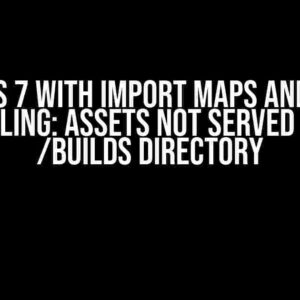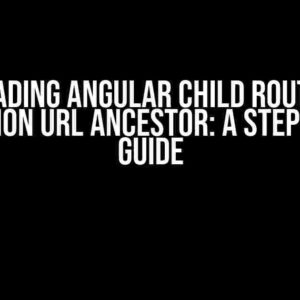Are you tired of reinventing the wheel every time you start a new Django project? Do you find yourself copying and pasting the same code snippets over and over again? It’s time to create a reusable Python Django library project that you can easily integrate into your future projects! In this article, we’ll take you through a step-by-step guide on how to build a Python Django library project from scratch.
- What is a Python Django Library Project?
- Why Should You Create a Python Django Library Project?
- Step 1: Create a New Python Package
- Step 2: Create a New Django App
- Step 3: Define Your Models
- Step 4: Define Your Views
- Step 5: Define Your URLs
- Step 6: Install Your Library Project
- Step 7: Use Your Library Project in a New Django Project
- Conclusion
- Frequently Asked Questions
- Table of Contents
What is a Python Django Library Project?
A Python Django library project is a reusable package of code that can be easily installed and used in multiple Django projects. It’s a way to encapsulate your code into a modular, reusable component that can be maintained and updated independently of your main project. Think of it as a plugin or a module that you can easily plug into any Django project.
Why Should You Create a Python Django Library Project?
There are many reasons why you should create a Python Django library project:
- Code Reusability**: By creating a library project, you can reuse your code in multiple projects, reducing the time and effort required to develop new features.
- Modularity**: A library project allows you to break down your code into smaller, independent components that can be maintained and updated separately.
- Easier Maintenance**: When you update your library project, you can easily distribute the changes to all projects that use it, without having to modify each project individually.
- Faster Development**: With a library project, you can speed up your development process by reusing existing code and focusing on new features.
Step 1: Create a New Python Package
To create a new Python package, you’ll need to create a new directory for your project and initialize it with setup.py and __init__.py files.
mylibrary/
setup.py
mylibrary/
__init__.py
__pycache__/
models/
__init__.py
mymodel.py
views/
__init__.py
myview.py
urls/
__init__.py
myurls.py
In the setup.py file, you’ll need to specify the metadata for your package, such as the name, version, and dependencies.
from setuptools import setup
setup(
name='mylibrary',
version='1.0',
packages=['mylibrary'],
install_requires=['Django>=3.2'],
)
Step 2: Create a New Django App
Inside your Python package, create a new Django app by running the following command:
python manage.py startapp myapp
This will create a new directory called myapp with the basic structure for a Django app.
Step 3: Define Your Models
In the models.py file, define your Django models using the models.Model class.
from django.db import models
class MyModel(models.Model):
name = models.CharField(max_length=255)
description = models.TextField()
Step 4: Define Your Views
In the views.py file, define your Django views using the views.View class.
from django.shortcuts import HttpResponse
from .models import MyModel
def my_view(request):
my_objects = MyModel.objects.all()
return HttpResponse('Hello, World!')
Step 5: Define Your URLs
In the urls.py file, define your Django URLs using the path function.
from django.urls import path
from . import views
urlpatterns = [
path('my_view/', views.my_view, name='my_view'),
]
Step 6: Install Your Library Project
To install your library project, navigate to the root directory of your project and run the following command:
pip install .
This will install your library project and make it available for use in other Django projects.
Step 7: Use Your Library Project in a New Django Project
To use your library project in a new Django project, you’ll need to install it using pip.
pip install mylibrary
Then, in your new Django project, add the following code to your settings.py file:
INSTALLED_APPS = [
# ...
'mylibrary',
]
Finally, you can use your library project in your new Django project by importing the models, views, and URLs as needed.
Conclusion
Building a Python Django library project is a great way to reuse your code and speed up your development process. By following the steps outlined in this guide, you can create a reusable package of code that can be easily installed and used in multiple Django projects.
Frequently Asked Questions
Q: What is the difference between a Python package and a Django app?
A: A Python package is a reusable package of code that can be installed and used in multiple projects. A Django app is a reusable component that can be used in multiple Django projects.
Q: How do I distribute my library project?
A: You can distribute your library project using pip by uploading it to PyPI or by hosting it on a private repository.
Q: Can I use my library project in non-Django projects?
A: Yes, you can use your library project in non-Django projects, but you’ll need to modify the code to be compatible with the new project.
Table of Contents
| Section | Description |
|---|---|
| What is a Python Django Library Project? | Definition and benefits of a Python Django library project |
| Step 1: Create a New Python Package | Create a new Python package with setup.py and __init__.py files |
| Step 2: Create a New Django App | Create a new Django app using the startapp command |
| Step 3: Define Your Models | Define your Django models using the models.Model class |
| Step 4: Define Your Views | Define your Django views using the views.View class |
| Step 5: Define Your URLs | Define your Django URLs using the path function |
| Step 6: Install Your Library Project | Install your library project using pip |
| Step 7: Use Your Library Project in a New Django Project | Use your library project in a new Django project by installing it and adding it to the INSTALLED_APPS setting |
| Conclusion | Summary of the benefits and steps to create a Python Django library project |
| Frequently Asked Questions | Common questions and answers about Python Django library projects |
We hope this guide has been helpful in creating a Python Django library project. Remember to follow best practices and keep your code organized and maintainable.
Here are 5 Questions and Answers about “python django library project” in a creative voice and tone, using HTML:
Frequently Asked Questions
If you’re just starting out with Python Django library projects, you probably have a few questions. Don’t worry, we’ve got you covered!
What is a Django library project, anyway?
A Django library project is a reusable application that can be installed into any Django project. It’s a self-contained bundle of models, views, templates, and URLs that can be easily shared across multiple projects. Think of it like a plugin for your Django project!
How do I create a new Django library project?
To create a new Django library project, you’ll need to run the command `django-admin startapp mylibrary` (replacing `mylibrary` with your desired library name). This will generate the basic directory structure for your library. Then, you can add your models, views, templates, and URLs as needed.
What’s the difference between a Django app and a Django library project?
A Django app is a self-contained application that is typically used within a single Django project. A Django library project, on the other hand, is a reusable application that can be installed into any Django project. Think of a Django app as a custom-built piece of furniture, while a Django library project is like a IKEA furniture set that can be easily assembled and used in any room (or project)!
How do I install a Django library project into my existing Django project?
To install a Django library project, you’ll need to add it to your `INSTALLED_APPS` setting in your Django project’s `settings.py` file. Then, run the command `python manage.py migrate` to sync the library’s database tables. Finally, you can use the library’s models, views, and URLs in your project!
Can I use a Django library project as a starting point for my own project?
Yes! Django library projects are perfect for kicking off your own project. You can use an existing library as a starting point and then customize it to fit your needs. Just be sure to read the library’s license and follow any requirements for using and modifying the code.
I hope this helps! Let me know if you have any other questions.

![Building a Python Django Library Project: A Step-by-Step Guide [Closed] Building a Python Django Library Project: A Step-by-Step Guide [Closed]](https://chanise.hkhazo.biz.id/wp-content/uploads/sites/523/2024/07/building-a-python-django-library-project-a-step-by-step-guide-closed-with-text.jpg)




